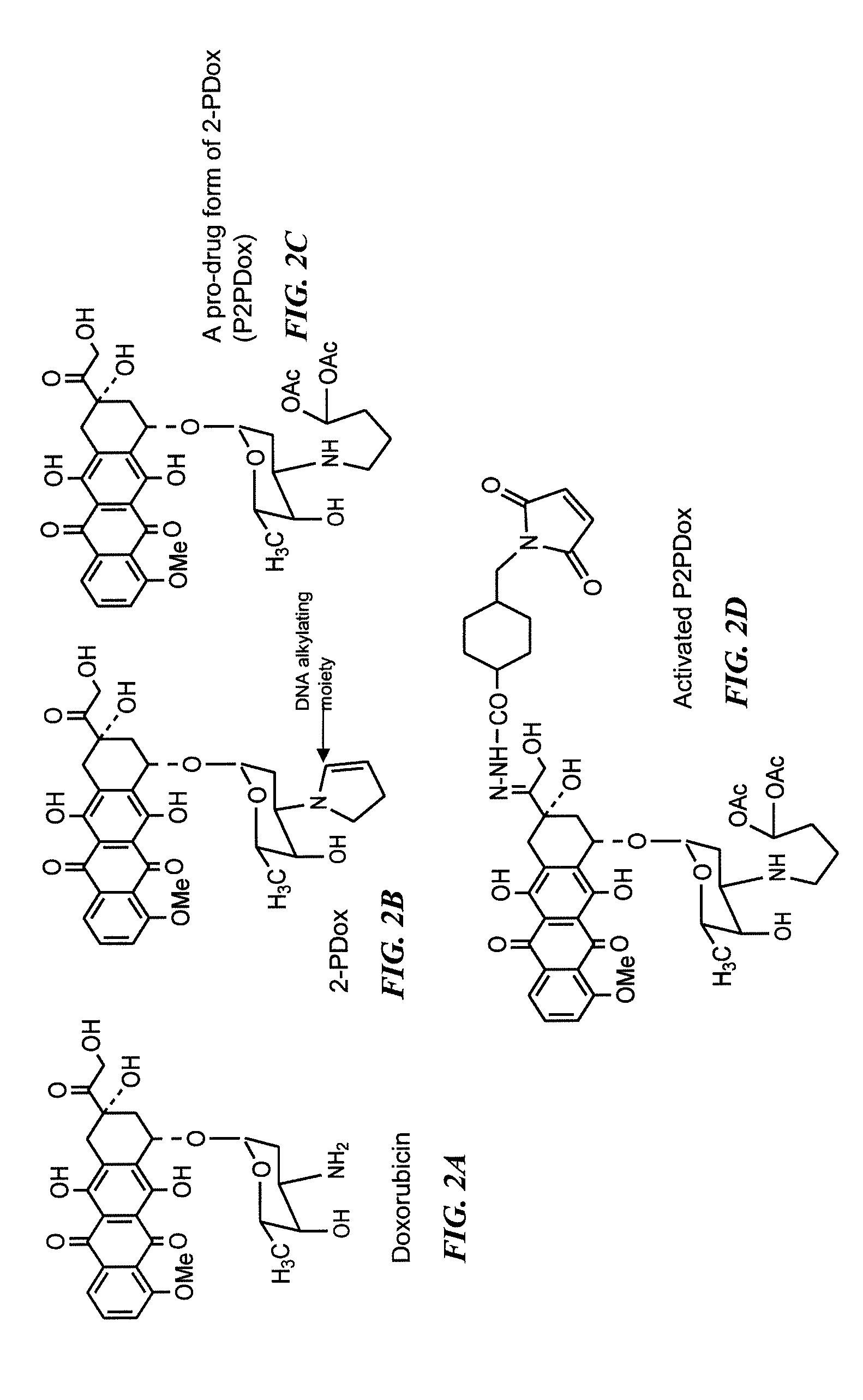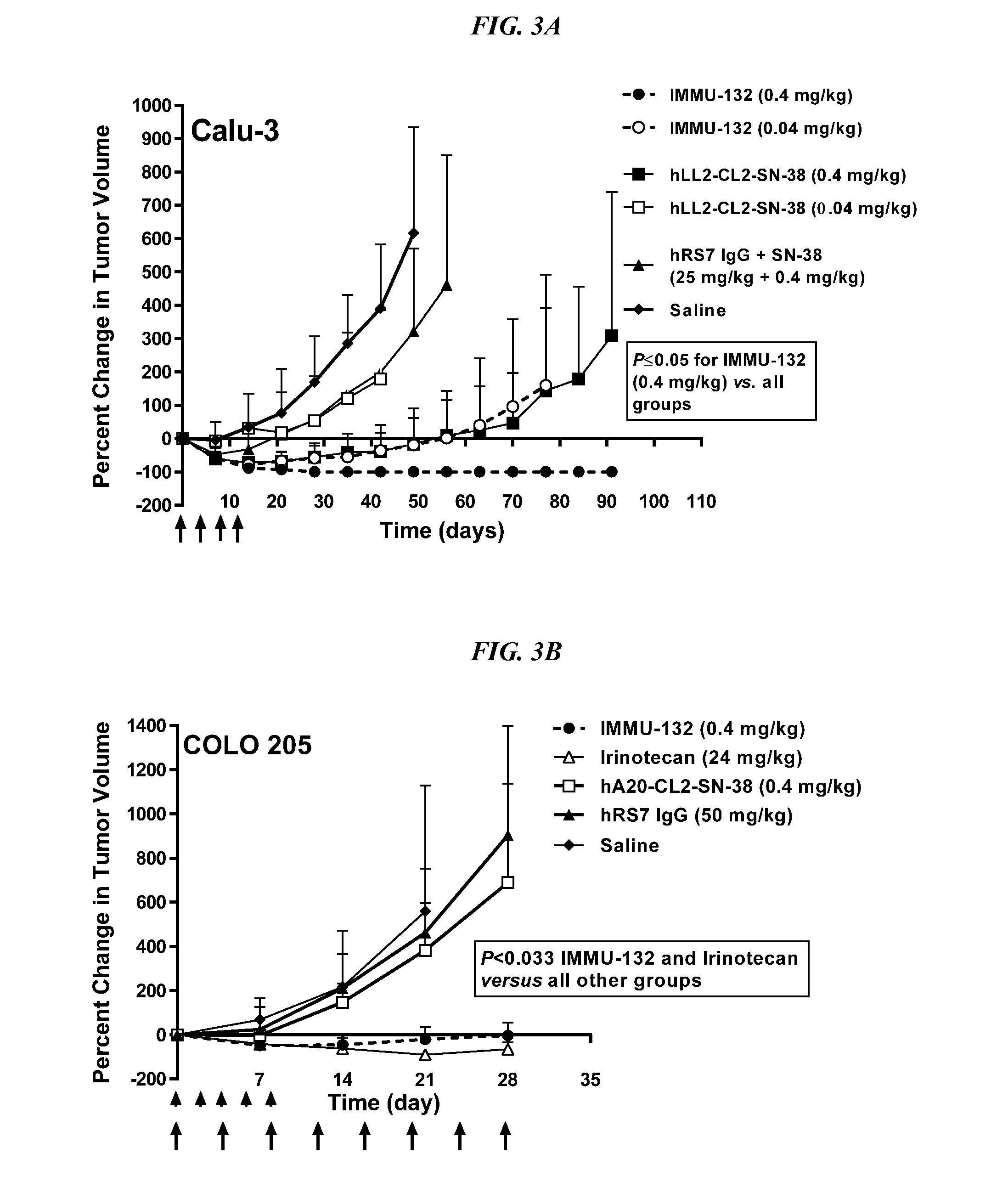Neoadjuvant use of antibody-drug conjugates
- Summary
- Abstract
- Description
- Claims
- Application Information
AI Technical Summary
Benefits of technology
Problems solved by technology
Method used
Image
Examples
Example
Example 1
Preparation of CL2A-SN-38 Immunoconjugates
[0222]In a preferred reaction scheme for synthesis of CL2A-SN-38, EEDQ (0.382 g) was added to a mixture of commercially available Fmoc-Lys(MMT)-OH (0.943 g) and p-aminobenzyl alcohol (0.190 g) in methylene choloride (10 mL) at room temperature and stirred for 4 h. Extractive work up followed by flash chromatograph yielded 1.051 g of material as white foam. Electrospray mass spectrum showed peaks at m / e 745.8 (M+H) and m / e 780.3 (M+Cl−), consistent with structure. The Lys(MMT)-PABOH intermediate (0.93 g) was dissolved in diethylamine (10 mL) and stirred for 2 h. After solvent removal, the residue was washed in hexane to obtain 0.6 g of the intermediate as colorless precipitate (91.6% pure by HPLC). HPLC ret. time: 2.06 min. Electrospray mass spectrum showed peaks at m / e 523.8 (M+H), m / e 546.2 (M+Na) and m / e 522.5 (M−H).
[0223]This crude intermediate (0.565 g) was coupled with commercially available O-(2-azidoethyl)-O′—(N-diglycolyl-2-...
Example
Example 2
Pre-Clinical Studies in Various Solid Tumors Treated with IMMU-132
[0229]In Vitro Characterization—
[0230]A TROP-2-positive human prostate carcinoma cell line, PC-3, was used as a target to assess possible changes in antigen binding by IMMU-132 in comparison to unconjugated hRS7 IgG. As measured on three separate occasions, there was no significant difference between the binding of IMMU-132 and unconjugated hRS7 IgG (KD-value, 0.658±0.140 nM vs. 0.564±0.055 nM, respectively).
[0231]Human neonatal receptor (FcRn) binding was determined by surface plasmon resonance (BIACore) analysis using a low density FcRn biosensor chip. Three binding runs using three separate sets of five dilutions for each test agent demonstrated that conjugation of SN-38 to hRS7 IgG did not significantly affect its binding affinity for FcRn (KD-values 92.4±5.7 nM and 191.9±47.6 nM, respectively; P=0.07).
[0232]TROP-2 is expressed in a wide range of human solid tumor cell lines, including TNBC cell lines (e....
Example
Example 3
In Vivo Studies in TNBC Treated with IMMU-132
[0235]IMMU-132 was assessed in mice bearing MDA-MB-468 TNBC tumors (FIG. 4A; doses are given in SN-38 equivalents). IMMU-132 (0.2 mg / kg) caused significant tumor regressions when compared to saline, irinotecan (6 mg / kg), or control anti-CD20 ADC, hA20-CL2A-SN-38 (P3 vs. 0.53±0.29 cm3, respectively; P=0.0094, two-tailed t-test). As was found in the other solid tumor models, specific targeting of a small amount of SN-38 to the tumor with IMMU-132 was much more effective than a much larger dose of untargeted drug.
[0236]On therapy day 56 (Day 78 post-transplant), tumors in mice in the low dose hA20-CL2A-SN-38 (anti-CD20) control group (0.12 mg / kg) progressed to a point that they were no different than saline control mice (TV=0.74±0.41 cm3 vs. 0.63±0.37 cm3, respectively). At that time-point, it was decided to determine if these tumors would respond to the IMMU-132 treatment, despite their progression to a considerably larger size (FI...
PUM
| Property | Measurement | Unit |
|---|---|---|
| Force | aaaaa | aaaaa |
| Length | aaaaa | aaaaa |
| Length | aaaaa | aaaaa |
Abstract
Description
Claims
Application Information
 Login to View More
Login to View More - R&D
- Intellectual Property
- Life Sciences
- Materials
- Tech Scout
- Unparalleled Data Quality
- Higher Quality Content
- 60% Fewer Hallucinations
Browse by: Latest US Patents, China's latest patents, Technical Efficacy Thesaurus, Application Domain, Technology Topic, Popular Technical Reports.
© 2025 PatSnap. All rights reserved.Legal|Privacy policy|Modern Slavery Act Transparency Statement|Sitemap|About US| Contact US: help@patsnap.com



